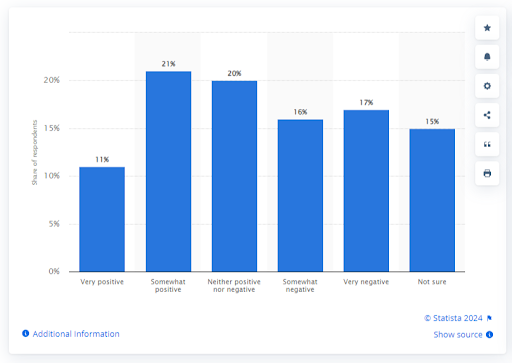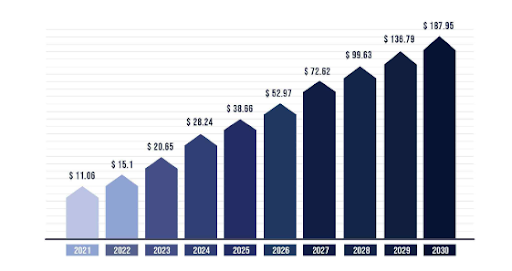Sector-Specific Insights: The Role of AI and ML in Different Industries
Ever since AI and ML have exploded into the tech industry, there has been just one question on everyone’s mind: will they eventually replace humans?
This concern has resulted in countless debates and a fair share of anxiety. However, as these technologies become a natural extension of daily experiences, the conversation has taken a new turn. Now, instead of worrying about being replaced, people are starting to ask a better question: how will AI and ML complement traditional job roles?
This blog will explore the true impact of AI and ML on modern businesses, their common use cases, consequent benefits, and emerging developments.
Artificial Intelligence vs Machine Learning
AI is a superset of various technologies that collectively aim to mimic human intelligence. ML, on the other hand, is one of AI’s key components that enables machines to learn from past data or actions instead of being explicitly programmed to do so. ML fits within the broader context of AI due to its core functionality: enabling systems to learn by developing contextual understanding through repeated exposure, much like humans learn by doing.
Overlap and Synergy
In a business context, both of these technologies work in synergy to improve overall efficiency. While AI provides the overall framework for automating tasks, ML fine-tunes these processes by analyzing historical data and continuously improving the system’s performance based on the findings.
Common AI and ML Use Cases for Modern Businesses
HR and Talent Management: Screening resumes, matching candidates to job descriptions, suggesting personalized development plans, analyzing employee performance, and predicting attrition risks.
Personalized Marketing: Delivering targeted marketing campaigns, analyzing customer behavior, predicting preferences, creating personalized product recommendations, optimizing ad spend, etc.
Customer Service Automation: Powering chatbots for 24/7 support, handling inquiries, resolving issues, learning from past interactions, and improving response accuracy over time.
Dynamic Pricing: Adjusting prices in real-time based on demand, analyzing competitor pricing, identifying pricing trends, and optimizing pricing strategies for maximum revenue.
Product Development and Innovation: Identifying market gaps, analyzing consumer feedback, predicting product success, guiding design improvements, and enhancing innovation strategies based on data insights.
Supply Chain Optimization: Forecasting demand, managing inventory levels, optimizing delivery routes, analyzing logistics data, and identifying potential disruptions to improve efficiency.
The Benefits of AI and ML in Enterprise Business Operations
Cost Reduction
Integrating various tasks with AI and ML can result in significant cost savings. AI can automate a wide range of tasks, from simple data entry and analysis to more complex tasks such as fraud and threat detection, and reducing reliance on humans. Additionally, AI automation also minimizes manual errors and allows your staff to focus on more value-adding activities.
Simultaneously, as ML analyzes volumes of data to identify patterns and trends, it can help in planning capacity by predicting future demand and resource requirements. Moreover, ML development can also help with predictive maintenance, allowing you to optimize equipment expenses and prepare for potential system failures well in advance. Over time, these efficiencies add up to better profit margins and better resource allocation.
Improved Risk Management
Besides automating data collection, the benefits of AI and ML extend to improved risk management activities. AI enables you to detect unusual patterns or anomalies that may point to fraud, compliance issues, or operational bottlenecks. The timely identification of such issues can help you stay ahead of potential risks.
On the other hand, ML can be used to study historical data on system failures, process inefficiencies, breaches, or compliance issues to recognize causality relationships. This information helps establish a benchmark of normal operational behavior by identifying the specific conditions that lead to these issues. Using this data, you can actively look for potentially troubling signs.
Enhanced Decision-Making
When it comes to providing insights for data-driven decision-making, the benefits of AI and ML begin with automating the collection of large volumes of data from disparate sources. These systems use advanced algorithms to transform this aggregated data into a consistent format and store it in a centralized repository for easier access and analysis. Moreover, AI algorithms can also provide a broad analysis of this centralized data.
In parallel, ML can refine the insights provided by AI systems. By continuously learning from newly added data and insights, it can get deeper into the trends and suggest iterative improvements for your business strategy. This continuous refinement can make you more responsive to market changes.
The Impact of AI and ML on Diverse Industries
Education
The impact of AI and ML on the education sector has been profound because of their ability to personalize learning experiences by adapting to individual styles and requirements. Moreover, related technologies such as AR and VR have also contributed to “immersive experiences that make students feel like they’re actually there,” as highlighted by Mark Zuckerberg. Consequently, the global market for AI in this sector is estimated to reach US$ 5,440.5 million by the end of this year.
However, despite the growing utility, people have yet to fully accept this development. While many have a positive outlook; others still worry about the true impact of AI and ML on education. Consider this, for instance:

The image above represents how adults (in the US alone) perceive AI and ML’s integration in the education sector. Clearly, there’s a lot to explore about the impact of AI and ML development.
Finance
In the finance sector, the impact of ML and AI extends to how financial institutions assess and manage risk and enhance the security of their operations. Fraud detection emerges as the most significant application, allowing companies to spot fraudulent activities by analyzing transaction data. Even in risk assessment and credit scoring, these technologies predict user actions based on their spending habits, payment history, and even social media activity. Algorithmic trading is another impactful application, where AI and ML algorithms help predict newer trading opportunities.
The market of AI in finance is projected to surpass US$ 44.08 billion by the end of this year and reach US$ 50.87 billion by 2029.
Healthcare
AI and ML have transformed how medical institutions and professionals predict patient outcomes and customize treatment plans. By analyzing historical health data, including imaging results, they can spot anomalies and malformations, such as lesions, facilitating faster diagnoses. Moreover, these technologies also help with the non-medical segment in healthcare—optimizing patient data entry, scheduling appointments, streamlining electronic health records, etc.
IBM Watson
You can trace back the initial impacts of AI and ML to IBM’s introduction of a healthcare-specific version of Watson, revealed in February 2011. The intelligent system combined various transformative technologies to assist doctors and researchers in analyzing volumes of patient data.
By 2030, the market of AI in healthcare is expected to surpass US$187.95 billion, exhibiting a CAGR of 37%. (Source)

Retail
In retail, AI and ML are improving both customers’ shopping experiences as well as retail business performance. The most prominent benefit for business owners is understanding consumer behavior through data insights, in terms of preferences, emotions, persona, etc.
These technologies are also significantly beneficial in managing inventories. They analyze sales data and trends to optimize stock levels, ensuring that popular items are readily available. Moreover, when combined with AI and ML, demand forecasting enhances retailers’ ability to anticipate consumer needs as they consider factors like market trends and economic conditions.
By offering personalized recommendations, they have helped consumers with faster and more accurate product discovery. Additionally, natural language processing enhances online shopping by allowing search engines to better understand user queries. This guidance leads to a smoother shopping experience and boosts overall customer satisfaction.
More recently, many businesses have also started offering immersive shopping experiences through AR/VR and computer vision features, allowing people to virtually try things on.
In this sector, the ML segment has a dominating share as user behavior analysis holds the utmost importance. Here is a rough breakdown of how various technologies are spanned within AI’s utility in the retail sector (Source)

The Next Wave of AI and ML Development
AI and ML are here to stay. With new developments emerging almost daily, it’s clear that these technologies are constantly evolving. As a result, their implementation and impact will look very different in the future compared to today. Here’s what you can expect to see in the coming years.
More Low-Code/No-Code (LCNC) Innovations
LCNC tools and platforms have enabled people without extensive technical knowledge to design, build, and deploy software products. In fact, Gartner predicts that professionals working outside of traditional IT departments will constitute at least 80% of the LCNC user base in the coming 2 years. The same trend is also visible in the AI and ML segments. AI-integrated LCNC platforms can further reduce development timelines by providing pre-configured components and real-time recommendations. This combination of advanced AI/ML algorithms and LCNC capabilities will likely continue to empower organizations.
Reliance on Hyper-Automation
Another key area of focus is hyper-automation. AI and ML systems are increasingly combined with traditional automation to carry out more intricate tasks. This will allow organizations to achieve higher productivity, reduce operational costs, and respond faster to market changes. So as hyper-automation grows, expected to exhibit a CAGR of 17.04% in the next decade, you can expect a more sophisticated involvement of AI and ML in this area.
Multi-Task Models
In the coming years, multi-task models will gain more prominence. These models are designed to handle multiple tasks simultaneously via shared knowledge mechanisms. This means that instead of deploying separate models for each task, companies can use a single multi-task model to perform various operations—such as sentiment analysis, language translation, etc. You can expect more of them in the coming years. However, as it’s a nascent development, you may need professional AI development services to build custom models that cater to your specific task requirements.
What’s Next
There’s still a lot more to happen in this area. Initially limited to automating repetitive tasks with some cognition, AI (and hence, ML) has evolved to solve more complex problems and enhance intricate business processes. As these technologies continue to advance, it’s exciting to think about the possibilities they’ll unlock in the years ahead.










